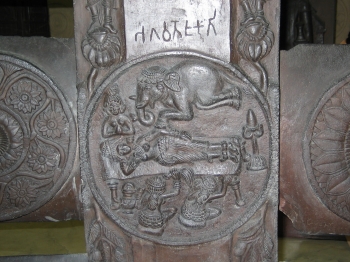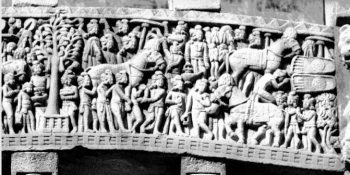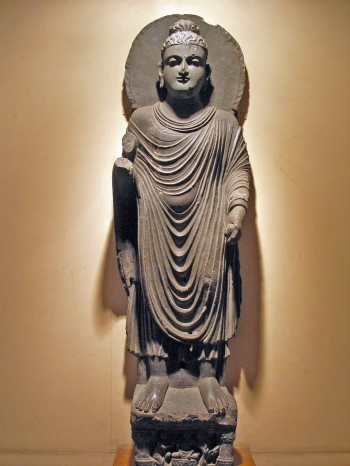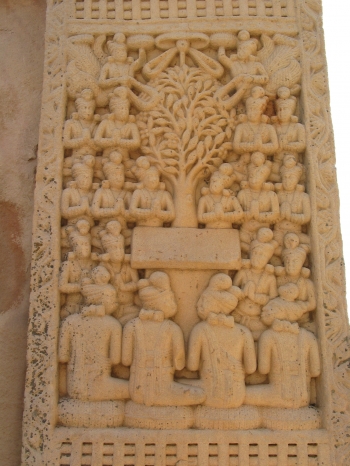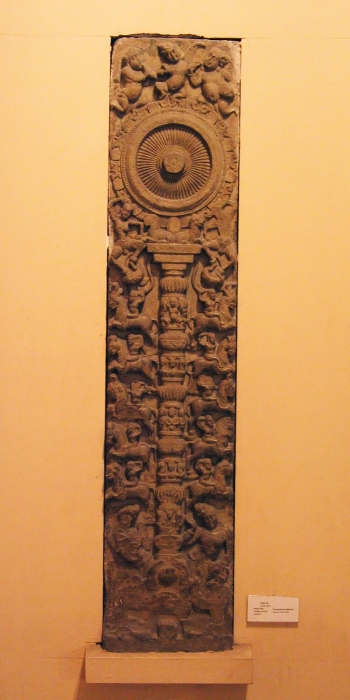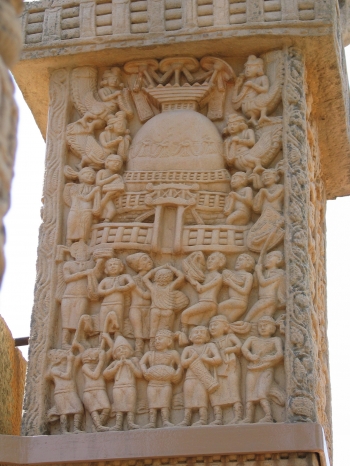Perhaps no religious icon is as widely used and well-known as the image of the Buddha seated in meditation. Yet one of the curiosities of history is that there is no evidence of images of the Buddha, of any kind, until nearly 400 years after the Buddha’s death.
French scholar Albert Foucher, one of the first to publish research on the subject, suggested in 1917 that the absence of the Buddha was not the lack of technical skill, but the absence of the idea of representing an anthropomorphic Buddha. “Buddhism did not develope, like Christianity, in a world long infected by the worship of images…,” Foucher explained in The Beginnings of Buddhist Art. Vedic texts had nothing to say on the issue, “either for or against: and their silence is explained precisely by the fact that the idea of it had not even presented itself to the Indian mind.” Buddhist texts, “from an iconographical point of view,” were similarly empty, “as sterile as the researches on the spot.” (Foucher, pp. 8-9).
_________________________________
_________________________________
Aniconism is a word from Greek and is encountered frequently in studies of the missing Buddha. It is formed from icon, or image, and the prefix of negation or absence, an. It is used among Buddhist scholars to describe this period of art history, and the art itself, in which there is no trace of an anthropomorphic Buddha. It’s not clear when this word was first used in histories of Buddhist art, but it is now quite well associated and appears frequently in article and book titles. (Collins English Dictionary and Random House Dictionary cite a late 19th century origin, and while the word or its variants do not appear in Foucher’s Beginnings, it does appear shortly thereafter in Coomaraswamy’s The Origin (1927).)
Encyclopedia Britannica defines the word as “opposition to the use of icons or visual images to depict living creatures or religious figures,” but the current definition at Wikipedia suggests a broader conception, one that “may be used to describe the absence of graphic representations in a particular belief system, regardless of whether an injunction against them exists.” The latter would fit well with a description of Buddhist aniconism as de facto, as opposed to prescriptive.
_________________________________________ Clearly, there was no reason why there couldn’t have been an anthropomorphic Buddha – if one had been wanted. Foucher argued implicitly for what Mettinger (1997), in his study of Jewish art, has described as de facto aniconism, a nonprescriptive absence of an anthropomorphized deity.
One might then wonder just what symbols were employed in this anthropomorphically challenged iconography. The art in question consists of stone carvings done in gates and railings surrounding stupas. What they depict will be an issue of some contention in the 1990’s, but until then the accepted wisdom was that these were scenes from the life of the Buddha, in particular, scenes depicting the four great miracles: the Buddha’s birth, his realization, the initiation of his 40 year teaching career, and his passing. The Buddha himself, shortly before his death, suggested that the locations of these four events could serve as sites of pilgrimage for the followers of his teachings.
One might then wonder just what symbols were employed in this anthropomorphically challenged iconography. The art in question consists of stone carvings done in gates and railings surrounding stupas. What they depict will be an issue of some contention in the 1990’s, but until then the accepted wisdom was that these were scenes from the life of the Buddha, in particular, scenes depicting the four great miracles: the Buddha’s birth, his realization, the initiation of his 40 year teaching career, and his passing. The Buddha himself, shortly before his death, suggested that the locations of these four events could serve as sites of pilgrimage for the followers of his teachings.
Foucher’s hypothesis was that artisans used symbols to represent these places, and that these symbols were in turn used in place of an anthropomorphic Buddha. Among them were:
- - The Bodhi tree, under which the Buddha attained his great insight in Bodhgaya (Figure 8);
- - The wheel of law, set turning when he taught his first students in Sarnath (Figure 9);
-
- - And the stupa, the container for his mortal remains in Kusinara (Figure 10).
Of his early life in Kapilavatthu, Foucher found at least two images, the elephant of Queen Maya’s dream heralding the birth of a sage (Figure 11), and the horse carrying the young Siddhartha Gautama from the palace to begin the spiritual quest (Figure 12). Foucher believed it wasn’t until the 1st century BCE that the Gandharans in northwest India (modern Afghanistan and Pakistan), working in a Greco-Roman-inspired style (Figure 13), introduced the idea of an anthropomorphized Buddha that slowly made its way throughout the Buddhist world and was then adapted to local forms of expression throughout the greater expanse of the Kusan empire.
Just over a decade after Foucher’s ideas were published, Sri Lankan scholar Ananda Coomaraswamy (1927) took issue with the idea of an extra-Indian source for the Buddha image. He looked instead to the work created in approximately the same period in Mathura, just south of present day Delhi, and went so far as to claim anthropomorphic traditions were of Dravidian, or southern, origin, while the aniconic tradition was Aryan, or northern. He did not, however, dispute the idea of a de facto aniconic period.
Like Foucher, Coomaraswamy recognized the absence of any textual interdiction or technical inability to produce likenesses of human figures. He went a bit further in suggesting aniconic art might represent a style in its own right, “at one time so universal, at least in orthodox and official circles, as to constitute by itself a complete artistic vocabulary and an iconography without icons.” He notes, furthermore, that this style was built out of a common collection of non-sectarian symbols used by Buddhists, Jains, and Brahmans alike.
Following Coomaraswamy, and for the next 60 years, the main issue of contention among scholars was whether the anthropomorphic Buddha had Greco-Roman or purely Indian origins. No one disputed an aniconic period.
Then, in 1985, American Buddhist scholar John Huntington made a rather startling claim. He proposed that Buddha images had been manufactured as early as shortly after the Buddha's death, thereby moving back the production of such images nearly four centuries - back to the very beginning of Buddhist history. His strongest piece of evidence was a Chinese ceramic pot adorned with a Buddha image dated to the middle of the first century BCE.
References
Coomaraswamy, AK. 1927 The Origin of the Buddha Image. The Art Bulletin. 9 (4) 287-329.
Foucher, A., Thomas, F. W., & Thomas, L. A. 1917. The beginnings of Buddhist art and other essays in Indian and Central-Asian archæology. Paris, P. Geuthner.
Mettinger, T. 1997 Israelite Aniconism: Developments and Origins. In The Image and the Book: Iconic Cult, Aniconism and the Rise of Book Religion in Israel and the Ancient Near East. K. Van Der Toorn. ed. Leuven: Uitgeverij Peeters. 173-204. Cited in Karlsson, K. 2006 The Formation of Early Buddhist Visual Culture. Material Religion. 2 (1) 68-95, p.73.
Photos
Figures 8, 9, 10, 11, and 13 from the collection of Dr David Efurd, Wofford College: http://www.artstor.org/what-is-artstor/w-html/col-efurd.shtml
Figure 12 from the Huntington Archive: http://www.huntingtonarchive.osu.adu
Back to In My Image series homepage
Figure 12 from the Huntington Archive: http://www.huntingtonarchive.osu.adu
Back to In My Image series homepage
